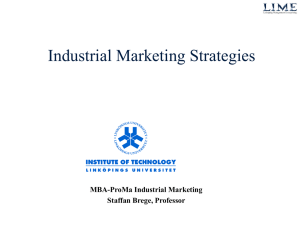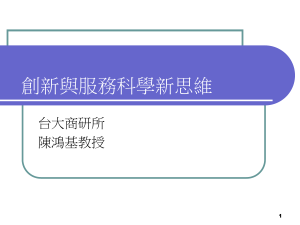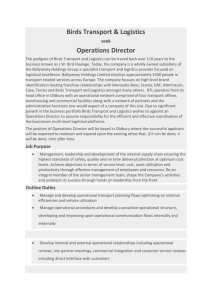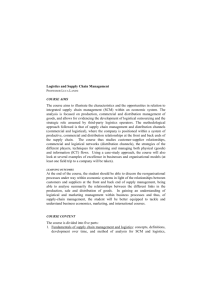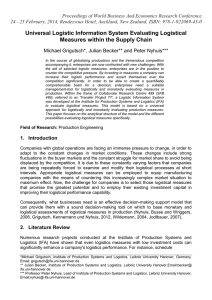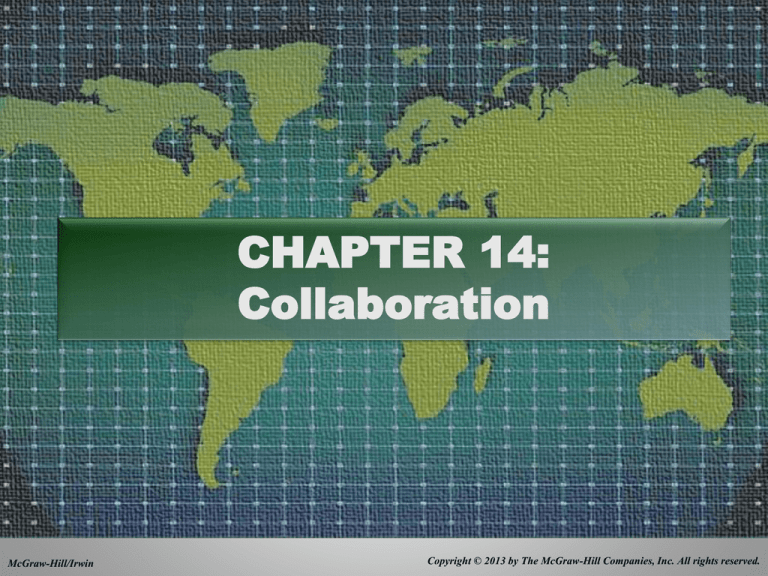
CHAPTER 14:
Collaboration
McGraw-Hill/Irwin
Copyright © 2013 by The McGraw-Hill Companies, Inc. All rights reserved.
Topics
• Logistical organization
• Development of collaborative relationships
• Relationship management
14-2
Overview of relationship development and
management
• Development and
management of internal
logistics relationships
• Development and
management of supply
chain relationships
14-3
Development and management of internal
logistics relationships
• Functional aggregation
• Shift from function to
process
• Virtual organization
• Leading organization
change
14-4
Sample historical view of dispersed
and fragmented logistics responsibility
Figure 14.1 Traditional Organization of Logistically Related Functions
14-5
Illustration of high functional aggregation
in logistics organization
Figure 14.2 Logistics Functional Aggregation
14-6
Functional aggregation is the combination of
logistics functions into a single managerial group
• Motivated by belief that grouping logistics into a single
organization would
– Increase likelihood of integration
– Improve knowledge of how operational changes impacts
performance in other areas
• Comprehensive aggregation in organizations is still rare,
but
– Trend is towards strategic management of all forms of inventory
movement and storage for maximum benefit of the enterprise
• Development of logistics information systems enabled
functional integration of organizations
14-7
Aspects of functional aggregation illustrated
in Figure 14.2
• Purchasing, Manufacturing Support and Customer
Relationship Management are separate line
operations
• Five capabilities under Logistical Support are
positioned as shared services
• Logistical Resource Planning embraces the full
potential of management information to plan and
coordinate operations
• Overall Planning and Control exist at the highest
level of the organization to facilitate integration
14-8
From function to process
• Process organization
structure
• Barriers to process
integration
• The great divide
14-9
Illustration of process-orientated supply
chain organization
Figure 14.4 Process Organization
14-10
Factors enabling the process structure
• Development of a highly involved work environment
with self-directed teams
• Improved productivity results found in organizations
that started managing processes rather than
function
• Ability to rapidly share accurate information
14-11
Challenges of managing from a process
perspective
• All effort must be focused on
value added to the customer
• All skills necessary to complete
the work must be available to
the process owner
– Critical skills not shared can
disrupt workflow and create
“bottlenecks”
• Work performed by processes
should stimulate synergism in
the organization
14-12
Barriers to process integration
• Functional organization
structure
– Department budgets
• Measurement & reward
systems
– Functional performance
•
Inventory use
– Traditional positioning supports
functional performance
•
Infocratic structure
– Information content and flow
follow traditional functions
• Limits to sharing knowledge
– Functional experts hoard power
14-13
The great divide reflects an organizational
gap in achieving end-to-end integration
Figure 14.3 The Great Divide: The Challenge of
Managing across Functional Boundaries
14-14
Virtual organization provides integrated
performance but is not on the organization chart
• How can an organization be
structured so that it can
manage a complex global
logistics process without
becoming too bureaucratic?
– Focus on work flow rather than
structure
– Link remote teams through
information networks
– Push authority down to teams
14-15
Disaggregation as an organizing principle
• Power of information
technology facilitates
performing and managing
logistics work without
combining functions into a
formal organization unit
• Belief that logistical
functionality need not be
grouped as a special
organization
– Performance can still be
efficiently and effectively
coordinated using information
networks
14-16
Leading organizational change
• General types of change
– Strategic change involves
implementation of new and
improved ways to service
customers
– Modifications in a firm’s
operational structure
– Changes in human
resource and organization
structure
• Critical to avoid a quick-fix
mentality about change
• Consider organization’s
capacity to absorb new
operational practices
– Typically less than most
change managers estimate
• Actual change takes
longer than anticipated
14-17
Development and management of supply
chain relationships
• Risk, power and
leadership
• Range of extended supply
chain relationships
• Supply chain integrative
framework
• Developing trust
14-18
Supply chain perspective places more
emphasis on external relationships
• Multi-enterprise coordinated effort focused on
supply chain efficiency improvement
• Belief that cooperative behavior will reduce risk and
greatly improve efficiency
• Belief that opportunity exists to eliminate waste and
work effort
14-19
Essential concepts to understanding
dependency
• Risk
– Disproportionate risk among channel members
– Collaborative role of member is based on risk within a specific supply chain
• Power
– Retailers have increased in power over the last decade
– Powerful firms tend to link together into supply chain arrangements
– Category dominance vs. brand power
• Leadership
– No dominate model for how firms gain leadership responsibility
– Greater commitment to the relationship when leaders use rewards and
expertise to exercise power
14-20
Range of extended supply chain
relationships
Figure 14.5 Relationship Classification Framework
14-21
Highlights of basic forms of
collaboration
•
Contracting
•
– Adds time dimension to traditional
buying/selling
– Governed by desire to voluntarily
work together both intellectually and
operationally
– Voluntary integration of human,
financial, operational and technical
resources
– Extensive joint planning and
expectations of ongoing relationship
• e.g. price, service and performance
expectations over specific period
•
Outsourcing
– Shifts focus from buying materials to
performing a specific service or
activity
•
Administered
– Dominate firm governs by command
and control
– Limited sharing of strategic
information and limited joint planning
– Relationship has no specific
termination or rebid time frame
Alliance (e.g. Walmart-Procter &
Gamble, Dell & suppliers, H.E. Butt &
suppliers)
•
Enterprise extension
– Extreme form of Alliance
14-22
Value creation from supply chain
integration is focused on flows
Figure 14.6 Supply Chain Flows
14-23
Description of supply chain flows
• Product/service value flow is the value-added movement of products
and services from raw material source to end customers
• Market accommodation flow provides a structure to achieve post
sales service administration
– E.g. product customization, POS data, end-customer consumption
• Information flow is bidirectional exchange of transactional data,
inventory status and strategic plans
– E.g. forecasts, promotional sales plans, purchase orders, invoices, etc.
• Cash flow typically follows the reverse direction of value-added
activities
– Cash flows to facilitate product and service movement using promotion and
rebate
14-24
Integrative framework showing supply
chain flows, competencies and context
Figure 14.7 Supply Chain Framework
14-25
Competencies are a fused set of capabilities
• Capability is the knowledge and achievement level
essential to developing integrated performance
– E.g. identify and accommodate specific customer needs,
measure and understand overall supply chain performance
– Reflects value contribution of work
– Why is the work performed rather than how
• Work is the most visible part of logistical operations
– E.g. order picking, truck driving
– Traditionally organized by function
– Functional work is driver of logistical best practice
14-26
Relationship of capabilities to competencies
and context of the supply chain
Table 14.1 Supply Chain Context, Competencies, and Supportive Capabilities
Set of capabilities that defines the
Customer Integration competency
14-27
Competencies needed for the operational
context
• Operational context involves processes that
facilitate order fulfillment and replenishment
– Customer integration builds on the activities that
develop intimacy
– Internal operations integration are joint activities
within a firm that coordinate functions related to
procurement, manufacture and customer
accommodation
– Supplier integration creates operational linkages with
material and service providers
14-28
Competencies needed for the planning and
control context
• Planning and control context involves monitoring,
controlling and facilitating overall supply chain
performance
– Technology and planning integration involves the
design, application and coordination of information
– Measurement integration is the ability to monitor and
benchmark functional and process performance
• Both within the firm and across the supply chain
14-29
Competency needed for the behavioral
context
• Behavioral context involves the quality of basic
business relationships between supply chain
partners
– Relationship integration involves the commitment
needed by people to build and develop successful longterm collaborative relationships
• Managers are often far more experienced in competition than
they are in collaboration
14-30
Initiating relationships
• Alliances are often initiated by the firm that was the
customer in the relationship
• The initiating firm should perform an in-depth
assessment of its internal practices, policies and
culture
– Will key alliance contacts be empowered to manage the
relationship?
– Does alliance involve a number of facilities that operate
under different conditions, capabilities or competitive
requirements?
14-31
Implementing relationships
• Partners should have
– Compatible cultures
– A common strategic vision
– Supportive operating philosophies
• Start small to foster early wins
– Acknowledge early wins
• To motivate key contacts
• To build confidence about alliance performance
• Implement the alliance in its simplest form
– Fine tune arrangement when improvement will add substantial
value
14-32
Maintaining relationships is dependent on
three key activities
• Mutual strategic and
operational goals
• Two-way performance
measurements
• Formal and informal
feedback mechanisms
14-33
Developing trust
• Real collaboration requires meaningful trust
• Power arrangements are often temporary and create
resistance to deeper collaboration
• How can trust be developed?
14-34
Reliability and character are two aspects of
trust
• Reliability-based trust is grounded in perception of actual
behavior and operating performance
– Firms perceived as incapable of delivering as promised are
perceived as unreliable
– Unreliable firms are unworthy of trust in a relationship
• Character-based trust is based on culture and philosophy
– Perception that partners are interested in each other’s welfare
– Trusting partners believe that each other will protect the other’s
interest
14-35
Building trust in relationships
• Trust develops over time and repeated
interactions among organizations
• First step is to demonstrate reliability in its
operations
• Second step is a full and frank sharing of
all information necessary for the effective
functioning of the relationship
– Firms that hoard information are not likely to
be trusted
• Trust can be maintained by sharing
explanations and business rationale for
key decisions
14-36

